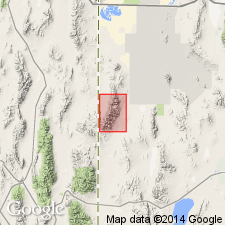
- Usage in publication:
-
- Horse Canyon Formation
- Modifications:
-
- Named
- Dominant lithology:
-
- Schist
- Quartzite
- AAPG geologic province:
-
- Great Basin province
Summary:
Named for Horse Canyon, T12S, R18W, Juab Co, UT in the Great Basin province. Rocks assigned to the Horse Canyon were part of the "Trout Creek Sequence" in earlier reports. Type section is on north side of Trout Creek Canyon in secs 18, 19, 20, 21, T12S, R18W. Is about 7,600 ft thick. Exposed in southern Deep Creek Mountains; exposures extend from Granite Canyon to south to Wood Canyon. Forms rugged cliffs. Divisible into 4 informal members; each member confined to a small area of Deep Creek Mountains. At the base, member a is a gray, brown-weathering, cliff-forming schist with some interbedded light-brown-weathering, thick bedded, vitreous, white quartzite 400 ft thick; member b is a red to gray quartz-muscovite-biotite schist with some garnet 1,100 ft thick; member c, 3,100 ft thick, varies in appearance due to the amount of quartzite which may be 10 to 100 ft thick that is interbedded with the schist; member d is a thick bedded, pink to gray quartzite 3,000 ft thick. The schists of member b contain angular to subround fragments of granite, gneiss, schist, quartzite, and marble that range from sand- to boulder-size (3 ft in diameter). Member a unconformably overlies formation C of unknown age. Member d unconformably underlies formation D of Precambrian and/or Cambrian age. Assigned to the Precambrian. Stratigraphic chart. Geologic map.
Source: GNU records (USGS DDS-6; Denver GNULEX).
For more information, please contact Nancy Stamm, Geologic Names Committee Secretary.
Asterisk (*) indicates published by U.S. Geological Survey authors.
"No current usage" (†) implies that a name has been abandoned or has fallen into disuse. Former usage and, if known, replacement name given in parentheses ( ).
Slash (/) indicates name conflicts with nomenclatural guidelines (CSN, 1933; ACSN, 1961, 1970; NACSN, 1983, 2005, 2021). May be explained within brackets ([ ]).

